Python网络爬虫——爬取哔哩哔哩网站原创视频以及其动漫视频
一、选题的背景
为什么要选择此选题?要达到的数据分析的预期目标是什么?(10 分)从社会、经济、技术、数据来源等方面进行描述(200 字以内)
选题原因:爬虫是指一段自动抓取互联网信息的程序,从互联网上抓取对于我们有价值的信息。选择此题正是因为随着信息化的发展,大数据时代对信息的采需求和集量越来越大,相应的处理量也越来越大,正是因为如此,爬虫相应的岗位也开始增多,因此,学好这门课也是为将来就业打下扎实的基础。B站在当今众多视频网站中,相对于年轻化较有爬取价值,可以进一步了解现阶段年轻人的观看喜好。
预期目标:熟悉地掌握爬取网页信息,将储存地信息进行清洗、查重并处理,并对其进行持久性可更新性地储存,然后对数据进行简单的可视化处理,最后再假设根据客户需求,提供快捷方便的相应的数据。
二、主题式网络爬虫设计方案(10 分)
1.主题式网络爬虫名称
爬取B站原创视频以及其动漫视频相关信息并反馈处理的程序
2.主题式网络爬虫爬取的内容与数据特征分析
内容:B站热门原创视频排名(视频标题、排名、播放量、弹幕量、作者网络名称、视频播放地址、作者空间地址);B站热门动漫的排名(排名,动漫标题,播放量,弹幕量,更新至集数,动漫播放地址)
数据特征分析:对前十名的视频进行制作柱状图(视频标题与播放量,视频排名与弹幕量,动漫标题与播放量,动漫排名与弹幕量)
3.主题式网络爬虫设计方案概述(包括实现思路与技术难点)
实现思路:
1.网络爬虫爬取B站的内容与数据进行分析
2.数据清洗和统计
3.mysql数据库的数据储存
技术难点:网页各信息上的标签属性查找,def自定义函数的建立,对存储至csv文件的数据进行清理查重,并且对其特点数据进行数据整数化(如:排名,播放量,弹幕量),对网址进行添加删除(如:添加“https://”,删除多余的“//”),机器学习sklearn库的学习与调用,selenium库的学习与调用。
三、主题页面的结构特征分析(10 分)
本次爬取两个同网址不同排行榜的主题页面(B站的原创视频排行榜、B站的动漫排行榜)的URL,分别为:“https://www.bilibili.com/v/popular/rank/all”与“https://www.bilibili.com/v/popular/rank/bangumi”。
Schema : https
Host : www.bilibili.com
Path : /v/popular/rank/all
/v/popular/rank/bangumi
主题页面组成为:<html>
<head>...</head>
<body class="header-v2">...<body>
<html>
B站的原创视频排行榜和B站的动漫排行榜的<head>标签中包含了<mate><title><script><link><style>五种标签,这些标签定义文档的头部,它是所有头部元素的容器。(附图)
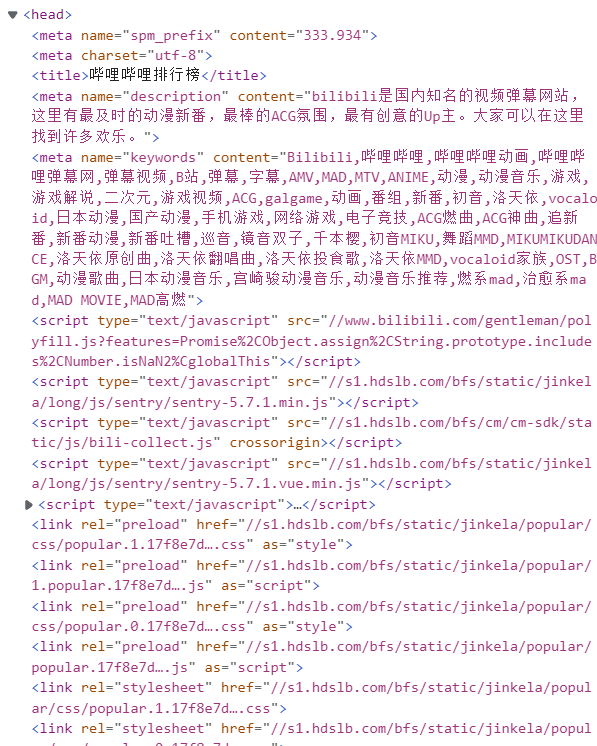
1.Htmls 页面解析
本次课程设计主要是对<body>部分进行解析,<body>中存在<svg><div><script><style>四种标签,经过定位,确定要爬取的数据位于<div id=”app”>的<li ...class=”rank-item”>标签中。
以下为爬取<li ...class=”rank-item”>标签中所有信息的代码:
import requests
from bs4 import BeautifulSoup
url = 'https://www.bilibili.com/v/popular/rank/all'
bdata = requests.get(url).text
soup = BeautifulSoup(bdata,'html.parser')
items = soup.findAll('li',{'class':'rank-item'})#提取列表
print(items)
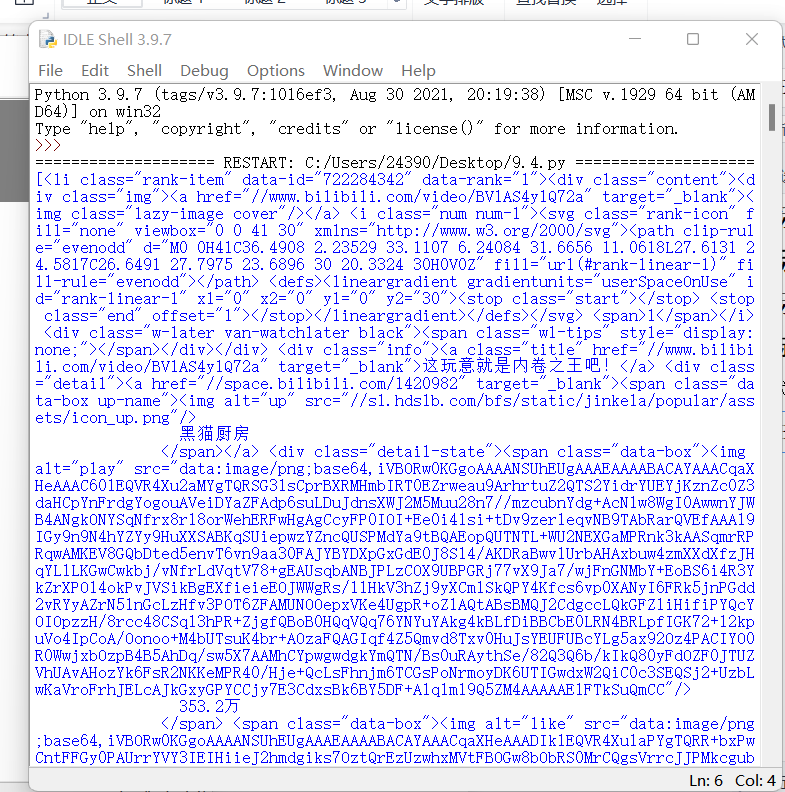
1.节点(标签)的查找方法与遍历方法(必要时画出节点树结构)
import requests
from bs4 import BeautifulSoup
r=requests.get('https://www.bilibili.com/v/popular/rank/all')
demo=r.text
soup=BeautifulSoup(demo,'html.parser')
#遍历方法:
print(soup.contents)# 获取整个标签树的儿子节点
print(soup.body.content)#返回标签树的body标签下的节点
print(soup.head)#返回head标签
#查找方法:
print(soup.title)#查找标签,这里查找了title标签
print(soup.li['class'])#根据标签名查找某属性,这里查找了li标签下的class
print(soup.find_all('li'))#根据标签名查找元素,这里查找了li标签下的所有代码
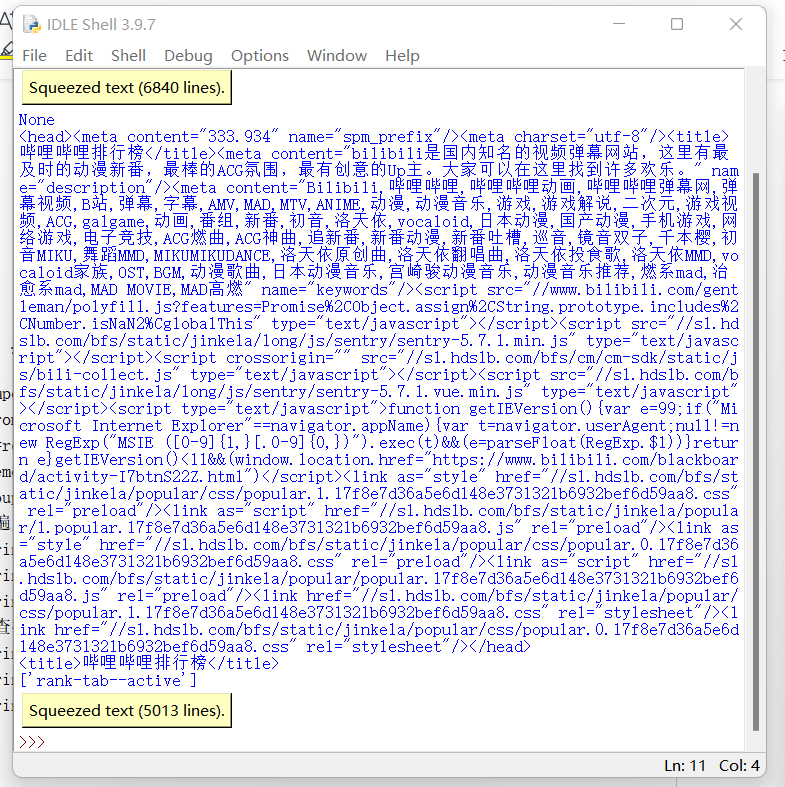
节点树结构图:

二、 网络爬虫程序设计(60分)
爬虫程序主体要包括以下各部分,要附源代码及较详细注释,并在每部分程序后面提供输出结果的截图。
1.数据爬取与采集
①bvid网址获取
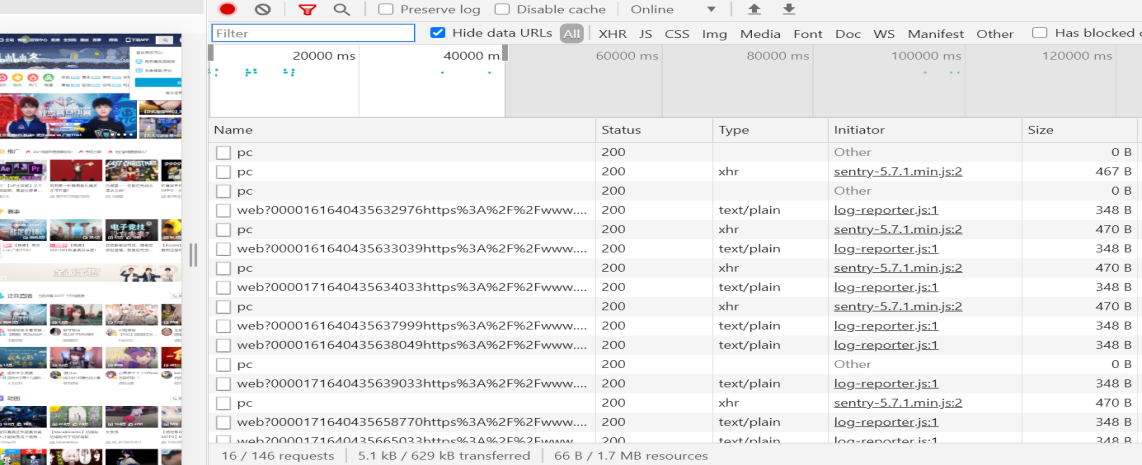

②aid的获取
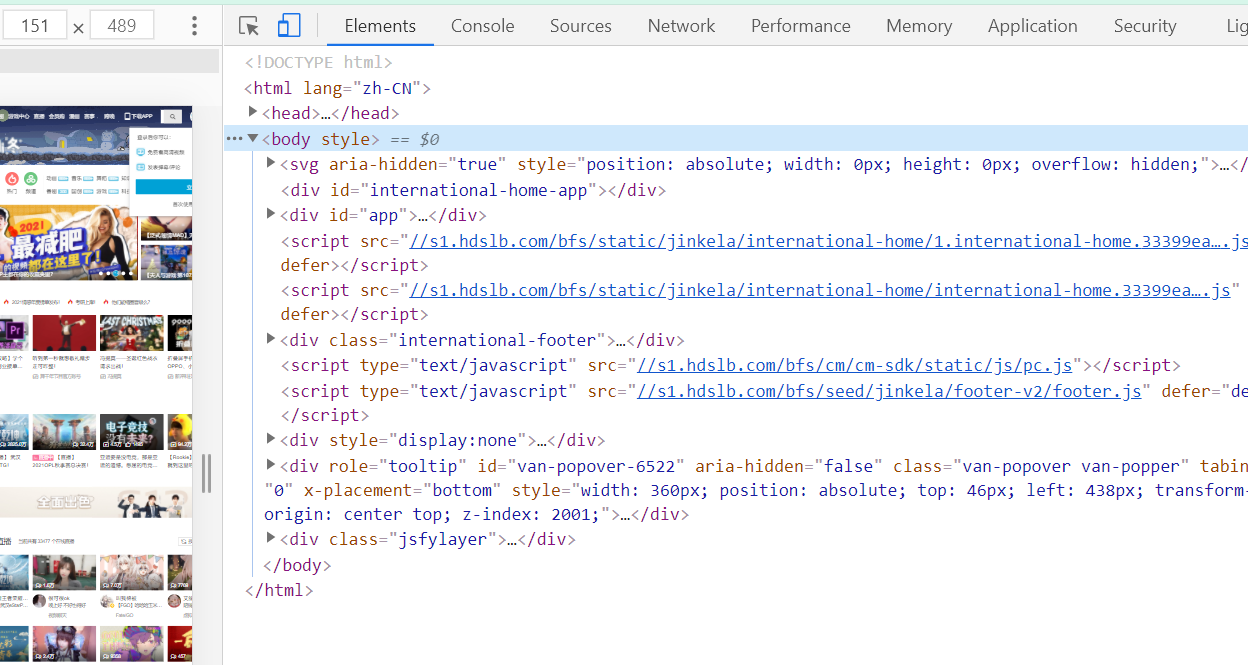

③爬取界面
1 #导入数据库 2 3 import requests 4 5 from bs4 import BeautifulSoup 6 7 import csv 8 9 import datetime 10 11 import pandas as pd 12 13 import numpy as np 14 15 from matplotlib import rcParams 16 17 import matplotlib.pyplot as plt 18 19 import matplotlib.font_manager as font_manager 20 21 from selenium import webdriver 22 23 from time import sleep 24 25 import matplotlib 26 27 url = 'https://www.bilibili.com/v/popular/rank/all' 28 29 #发起网络请求 30 31 response = requests.get(url) 32 33 html_text = response.text 34 35 soup = BeautifulSoup(html_text,'html.parser') 36 37 #创建Video对象 38 39 class Video: 40 41 def __init__(self,rank,title,visit,barrage,up_id,url,space): 42 43 self.rank = rank 44 45 self.title = title 46 47 self.visit = visit 48 49 self.barrage = barrage 50 51 self.up_id = up_id 52 53 self.url = url 54 55 self.space = space 56 57 def to_csv(self): 58 59 return[self.rank,self.title,self.visit,self.barrage,self.up_id,self.url,self.space] 60 61 @staticmethod 62 63 def csv_title(): 64 65 return ['排名','标题','播放量','弹幕量','Up_ID','URL','作者空间'] 66 67 #提取列表 68 69 items = soup.findAll('li',{'class':'rank-item'}) 70 71 #保存提取出来的Video列表 72 73 videos = [] 74 75 for itm in items: 76 77 title = itm.find('a',{'class':'title'}).text #视频标题 78 79 rank = itm.find('i',{'class':'num'}).text #排名 80 81 visit = itm.find_all('span')[3].text #播放量 82 83 barrage = itm.find_all('span')[4].text #弹幕量 84 85 up_id = itm.find('span',{'class':'data-box up-name'}).text #作者id 86 87 url = itm.find_all('a')[1].get('href')#获取视频网址 88 89 space = itm.find_all('a')[2].get('href')#获取作者空间网址 90 91 v = Video(rank,title,visit,barrage,up_id,url,space) 92 93 videos.append(v) 94 95 #建立时间后缀 96 97 now_str = datetime.datetime.now().strftime('%Y%m%d_%H%M%S') 98 99 #建立文件名称以及属性 100 101 file_name1 = f'哔哩哔哩视频top100_{now_str}.csv' 102 103 #写入数据到文件中,并存储 104 105 with open(file_name1,'w',newline='',encoding='utf-8') as f: 106 107 writer = csv.writer(f) 108 109 writer.writerow(Video.csv_title()) 110 111 for v in videos: 112 113 writer.writerow(v.to_csv()) 114 115 url = 'https://www.bilibili.com/v/popular/rank/bangumi' 116 117 #发起网络请求 118 119 response = requests.get(url) 120 121 html_text = response.text 122 123 soup = BeautifulSoup(html_text,'html.parser') 124 125 #创建Video对象 126 127 class Video: 128 129 def __init__(self,rank,title,visit,barrage,new_word,url): 130 131 self.rank = rank 132 133 self.title = title 134 135 self.visit = visit 136 137 self.barrage = barrage 138 139 self.new_word = new_word 140 141 self.url = url 142 143 def to_csv(self): 144 145 return[self.rank,self.title,self.visit,self.barrage,self.new_word,self.url] 146 147 @staticmethod 148 149 def csv_title(): 150 151 return ['排名','标题','播放量','弹幕量','更新话数至','URL'] 152 153 #提取列表 154 155 items = soup.findAll('li',{'class':'rank-item'}) 156 157 #保存提取出来的Video列表 158 159 videos = [] 160 161 for itm in items: 162 163 rank = itm.find('i',{'class':'num'}).text #排名 164 165 title = itm.find('a',{'class':'title'}).text #视频标题 166 167 url = itm.find_all('a')[0].get('href')#获取视频网址 168 169 visit = itm.find_all('span')[2].text #播放量 170 171 barrage = itm.find_all('span')[3].text #弹幕量 172 173 new_word = itm.find('span',{'class':'data-box'}).text#更新话数 174 175 v = Video(rank,title,visit,barrage,new_word,url) 176 177 videos.append(v) 178 179 #建立时间后缀 180 181 now_str = datetime.datetime.now().strftime('%Y%m%d_%H%M%S') 182 183 #建立文件名称以及属性 184 185 file_name2 = f'哔哩哔哩番剧top50_{now_str}.csv' 186 187 #写入数据到文件中,并存储 188 189 with open(file_name2,'w',newline='',encoding='utf-8') as f: 190 191 writer = csv.writer(f) 192 193 writer.writerow(Video.csv_title()) 194 195 for v in videos: 196 197 writer.writerow(v.to_csv())
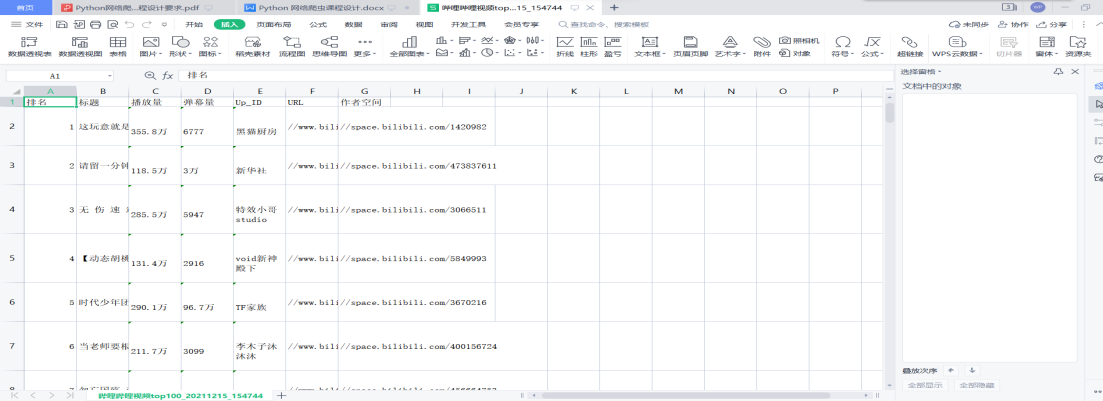

④清洗数据
1 #导入数据库 2 3 import pandas as pd 4 5 file_name1 = f'哔哩哔哩视频top100_20211215_154744.csv' 6 7 file_name2 = f'哔哩哔哩番剧top50_20211215_154745.csv' 8 9 paiming1 = pd.DataFrame(pd.read_csv(file_name1,encoding="utf_8_sig"))#对数据进行清洗和处理 10 11 paiming2 = pd.DataFrame(pd.read_csv(file_name2,encoding="utf_8_sig")) 12 13 print(paiming1.head()) 14 15 print(paiming2.head()) 16 17 #查找重复值 18 19 print(paiming1.duplicated()) 20 21 print(paiming2.duplicated()) 22 23 #查找空值与缺失值 24 25 print(paiming1['标题'].isnull().value_counts()) 26 27 print(paiming2['标题'].isnull().value_counts()) 28 29 print(paiming1['URL'].isnull().value_counts()) 30 31 print(paiming2['URL'].isnull().value_counts()) 32 33 print(paiming1['播放量'].isnull().value_counts()) 34 35 print(paiming2['播放量'].isnull().value_counts()) 36 37 print(paiming1['弹幕量'].isnull().value_counts()) 38 39 print(paiming2['弹幕量'].isnull().value_counts())
2.储存至mysql数据库当中
①爬取网站
1 # 爬取B站日榜新闻 2 3 def BilibiliNews(): 4 5 newsList=[] 6 7 # 伪装标头 8 9 headers={'User-Agent': 'Mozilla/5.0 (Windows NT 10.0; Win64; x64) AppleWebKit/537.36 (KHTML, like Gecko) Chrome/81.0.4044.122 Safari/537.36'} 10 11 res=requests.get('https://www.bilibili.com/ranking/all/0/0/3',headers=headers) # 请求网页 12 13 soup = BeautifulSoup(res.text,'html.parser') # 解析网页 14 15 result=soup.find_all(class_='rank-item') # 找到榜单所在标签 16 17 num=0 18 19 startTime=time.strftime("%Y-%m-%d", time.localtime()) # 记录爬取的事件 20 21 for i in result: 22 23 try: 24 25 num=int(i.find(class_='num').text) # 当前排名 26 27 con=i.find(class_='content') 28 29 title=con.find(class_='title').text # 标题 30 31 detail=con.find(class_='detail').find_all(class_='data-box') 32 33 play=detail[0].text # 播放量 34 35 view=detail[1].text # 弹幕量 36 37 # 由于这两者存在类似15.5万的数据情况,所以为了保存方便将他们同义转换为整型 38 39 if(play[-1]=='万'): 40 41 play=int(float(play[:-1])*10000) 42 43 if(view[-1]=='万'): 44 45 view=int(float(view[:-1])*10000) 46 47 # 以下为预防部分数据不显示的情况 48 49 if(view=='--'): 50 51 view=0 52 53 if(play=='--'): 54 55 play=0 56 57 author=detail[2].text # UP主 58 59 60 61 url=con.find(class_='title')['href'] # 获取视频链接 62 63 BV=re.findall(r'https://www.bilibili.com/video/(.*)', url)[0] # 通过正则表达式解析得到视频的BV号 64 65 pts=int(con.find(class_='pts').find('div').text) # 视频综合得分 66 67 newsList.append([num,title,author,play,view,BV,pts,startTime]) # 将数据插入列表中 68 69 except: 70 71 continue 72 73 return newsList # 返回数据信息列表

②数据库的创建
1 mysql> create table BILIBILI( 2 3 -> NUM INT, 4 5 -> TITLE CHAR(80), 6 7 -> UP CHAR(20), 8 9 -> VIEW INT, 10 11 -> COMMENT INT, 12 13 -> BV_NUMBER INT, 14 15 -> SCORE INT, 16 17 -> EXECUTION_TIME DATETIME);

③将数据插入MySQL中
1 def GetMessageInMySQL(): 2 3 # 连接数据库 4 5 db = pymysql.connect(host="cdb-cdjhisi3hih.cd.tencentcdb.com",port=10056,user="root",password="xxxxxx",database="weixinNews",charset='utf8') 6 7 cursor = db.cursor() # 创建游标 8 9 news=getHotNews() # 调用getHotNews()方法获取热搜榜数据内容 10 11 sql = "INSERT INTO WEIBO(NUMBER_SERIAL,TITLE, ATTENTION,EXECUTION_TIME) VALUES (%s,%s,%s,%s)" # 插入语句 12 13 timebegin=time.strftime("%Y-%m-%d %H:%M:%S", time.localtime()) # 记录开始事件,便于查找错误发生情况 14 15 try: 16 17 # 执行sql语句,executemany用于批量插入数据 18 19 cursor.executemany(sql, news) 20 21 # 提交到数据库执行 22 23 db.commit() 24 25 print(timebegin+"成功!") 26 27 except : 28 29 # 如果发生错误则回滚 30 31 db.rollback() 32 33 print(timebegin+"失败!") 34 35 # 关闭游标 36 37 cursor.close() 38 39 # 关闭数据库连接 40 41 db.close()
④利用schedule实现定时爬取
1 # 记录程序运行事件 2 3 time1=time.strftime("%Y-%m-%d %H:%M:%S", time.localtime()) 4 5 print("开始爬取信息,程序正常执行:"+time1) 6 7 # 每20分钟执行一次程序 8 9 schedule.every(20).minutes.do(startFunction) 10 11 # 检查部署的情况,如果任务准备就绪,就开始执行任务 12 13 while True: 14 15 schedule.run_pending() 16 17 time.sleep(1)
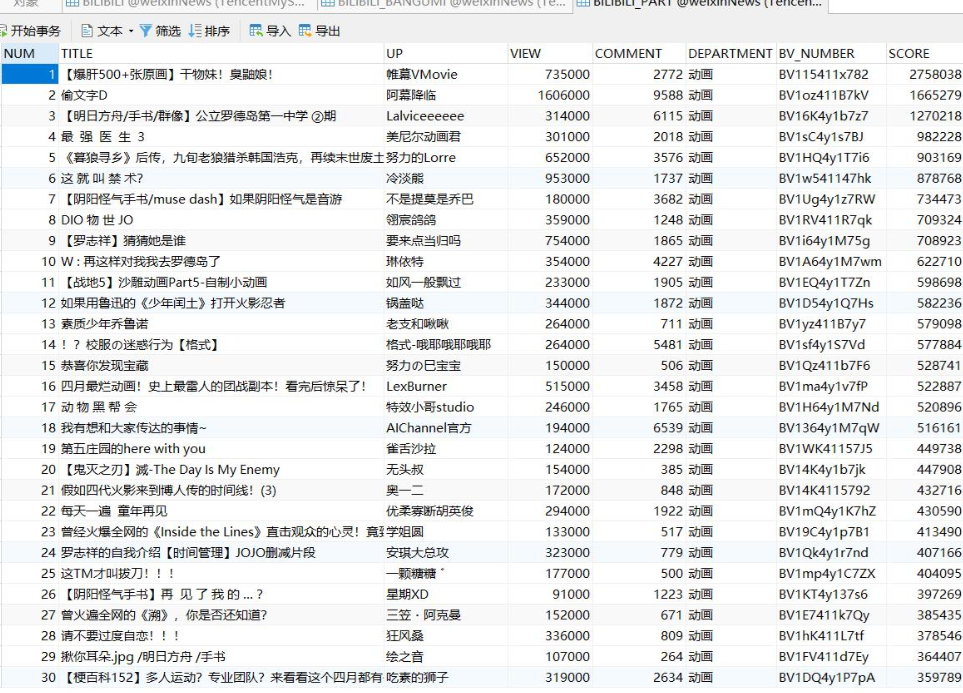

3.flask开发服务器端
①jieba提词和echarts wordcloud
1 from collections import Counter 2 from pyecharts import WordCloud 3 import jieba.analyse 4 # 将counter拆分成两个list 5 def counter2list(counter): 6 keyList,valueList = [],[] 7 for c in counter: 8 keyList.append(c[0]) 9 valueList.append(c[1]) 10 return keyList,valueList 11 # 使用jieba提取关键词并计算权重 12 def extractTag(content,tagsList): 13 keyList,valueList = [],[] 14 if content: 15 tags = jieba.analyse.extract_tags(content, topK=100, withWeight=True) 16 for tex, widget in tags: 17 tagsList[tex] += int(widget*10000) 18 19 def drawWorldCloud(content,count): 20 outputFile = './测试词云.html' 21 cloud = WordCloud('词云图', width=1000, height=600, title_pos='center') 22 cloud.add( 23 ' ',content,count, 24 shape='circle', 25 background_color='white', 26 max_words=200 27 ) 28 cloud.render(outputFile) 29 if __name__ == '__main__': 30 c = Counter() #建一个容器 31 filePath = './新建文本文档.txt' #分析的文档路径 32 with open(filePath) as file_object: 33 contents = file_object.read() 34 extractTag(contents, c) 35 contentList,countList = counter2list(c.most_common(200)) 36 drawWorldCloud(contentList, countList)
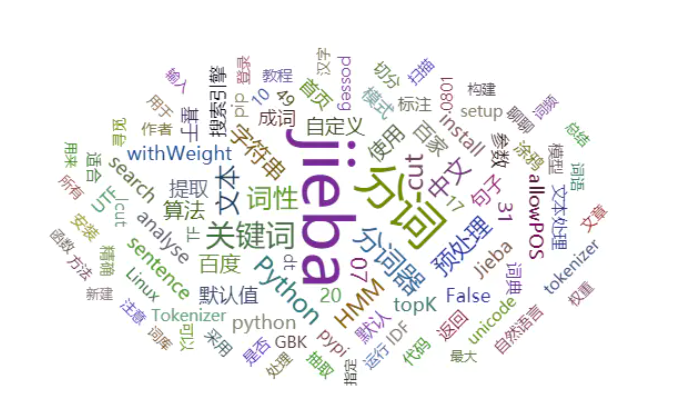
②flask接受请求的参数
1 username = request.form.get("username") 2 password = request.form.get("password", type=str, default=None) 3 cpuCount = request.form.get("cpuCount", type=int, default=None) 4 memorySize = request.form.get("memorySize", type=int, default=None)

③BV爬取
1 # _*_ coding: utf-8 _*_ 2 3 from urllib.request import urlopen, Request 4 5 from http.client import HTTPResponse 6 7 from bs4 import BeautifulSoup 8 9 import gzip 10 11 import json 12 13 def get_all_comments_by_bv(bv: str, time_order=False) -> tuple: 14 15 """ 16 17 根据哔哩哔哩的BV号,返回对应视频的评论列表(包括评论下面的回复) 18 19 :param bv: 视频的BV号 20 21 :param time_order: 是否需要以时间顺序返回评论,默认按照热度返回 22 23 :return: 包含三个成员的元组,第一个是所有评论的列表(评论的评论按原始的方式组合其中,字典类型) 24 25 第二个是视频的AV号(字符串类型),第三个是统计到的实际评论数(包括评论的评论) 26 27 """ 28 29 video_url = 'https://www.bilibili.com/video/' + bv 30 31 headers = { 32 33 'Host': 'www.bilibili.com', 34 35 'User-Agent': 'Mozilla/5.0 (Windows NT 10.0; Win64; x64; rv:74.0) Gecko/20100101 Firefox/74.0', 36 37 'Accept': 'text/html,application/xhtml+xml,application/xml;q=0.9,image/webp,*/*;q=0.8', 38 39 'Accept-Language': 'zh-CN,zh;q=0.8,zh-TW;q=0.7,zh-HK;q=0.5,en-US;q=0.3,en;q=0.2', 40 41 'Accept-Encoding': 'gzip, deflate, br', 42 43 'Connection': 'keep-alive', 44 45 'Cookie': '', 46 47 'Upgrade-Insecure-Requests': '1', 48 49 'Cache-Control': 'max-age=0', 50 51 'TE': 'Trailers', 52 53 } 54 55 rep = Request(url=video_url, headers=headers) # 获取页面 56 57 html_response = urlopen(rep) # type: HTTPResponse 58 59 html_content = gzip.decompress(html_response.read()).decode(encoding='utf-8') 60 61 bs = BeautifulSoup(markup=html_content, features='html.parser') 62 63 comment_meta = bs.find(name='meta', attrs={'itemprop': 'commentCount'}) 64 65 av_meta = bs.find(name='meta', attrs={'property': 'og:url'}) 66 67 comment_count = int(comment_meta.attrs['content']) # 评论总数 68 69 av_number = av_meta.attrs['content'].split('av')[-1][:-1] # AV号 70 71 print(f'视频 {bv} 的AV号是 {av_number} ,元数据中显示本视频共有 {comment_count} 条评论(包括评论的评论)。') 72 73 74 75 page_num = 1 76 77 replies_count = 0 78 79 res = [] 80 81 while True: 82 83 # 按时间排序:type=1&sort=0 84 85 # 按热度排序:type=1&sort=2 86 87 comment_url = f'https://api.bilibili.com/x/v2/reply?pn={page_num}&type=1&oid={av_number}' + \ 88 89 f'&sort={0 if time_order else 2}' 90 91 comment_response = urlopen(comment_url) # type: HTTPResponse 92 93 comments = json.loads(comment_response.read().decode('utf-8')) # type: dict 94 95 comments = comments.get('data').get('replies') # type: list 96 97 if comments is None: 98 99 break 100 101 replies_count += len(comments) 102 103 for c in comments: # type: dict 104 105 if c.get('replies'): 106 107 rp_id = c.get('rpid') 108 109 rp_num = 10 110 111 rp_page = 1 112 113 while True: # 获取评论下的回复 114 115 reply_url = f'https://api.bilibili.com/x/v2/reply/reply?' + 116 117 f'type=1&pn={rp_page}&oid={av_number}&ps={rp_num}&root={rp_id}' 118 119 reply_response = urlopen(reply_url) # type: HTTPResponse 120 121 reply_reply = json.loads(reply_response.read().decode('utf-8')) # type: dict 122 123 reply_reply = reply_reply.get('data').get('replies') # type: dict 124 125 if reply_reply is None: 126 127 break 128 129 replies_count += len(reply_reply) 130 131 for r in reply_reply: # type: dict 132 133 res.append(r) 134 135 if len(reply_reply) < rp_num: 136 137 break 138 139 rp_page += 1 140 141 c.pop('replies') 142 143 res.append(c) 144 145 if replies_count >= comment_count: 146 147 break 148 149 page_num += 1 150 151 152 153 print(f'实际获取视频 {bv} 的评论总共 {replies_count} 条。') 154 155 return res, av_number, replies_count 156 157 if __name__ == '__main__': 158 159 cts, av, cnt = get_all_comments_by_bv('BV1op4y1X7N2') 160 161 for i in cts: 162 163 print(i.get('content').get('message'))

2.数据分析可视化(例如:数据柱形图、直方图、散点图、盒图、分布图)
1 #数据分析以及可视化 2 3 filename1 = file_name1 4 5 filename2 = file_name2 6 7 with open(filename1,encoding="utf_8_sig") as f1: 8 9 #创建阅读器(调用csv.reader()将前面存储的文件对象最为实参传给它) 10 11 reader1 = csv.reader(f1) 12 13 #调用了next()一次,所以这边只调用了文件的第一行,并将头文件存储在header_row中 14 15 header_row1 = next(reader1) 16 17 print(header_row1) 18 19 #指出每个头文件的索引 20 21 for index,column_header in enumerate(header_row1): 22 23 print(index,column_header) 24 25 #建立空列表 26 27 title1 = [] 28 29 rank1 = [] 30 31 highs1=[] 32 33 url1 = [] 34 35 visit1 = [] 36 37 space1 = [] 38 39 up_id1 = [] 40 41 for row in reader1: 42 43 rank1.append(row[0]) 44 45 title1.append(row[1]) 46 47 visit1.append(row[2].strip('\n').strip(' ').strip('\n')) 48 49 highs1.append(row[3].strip('\n').strip(' ').strip('\n')) 50 51 up_id1.append(row[4].strip('\n').strip(' ').strip('\n')) 52 53 url1.append(row[5].strip('\n').strip(' ').strip('\n').strip('//')) 54 55 space1.append(row[6].strip('\n').strip(' ').strip('\n').strip('//')) 56 57 visit1 = str(visit1) 58 59 visit1 = visit1.replace('万', '000') 60 61 visit1 = visit1.replace('.', '') 62 63 visit1 = eval(visit1) 64 65 visit_list_new1 = list(map(int, visit1)) 66 67 highs1 = str(highs1) 68 69 highs1 = highs1.replace('万', '000') 70 71 highs1 = highs1.replace('.', '') 72 73 highs1 = eval(highs1) 74 75 highs_list_new1 = list(map(int, highs1)) 76 77 print(highs_list_new1) 78 79 #设置x轴数据 80 81 x=np.array(rank1[0:10]) 82 83 #设置y轴数据 84 85 y=np.array(highs_list_new1[0:10]) 86 87 # 绘制柱状图,并把每根柱子的颜色设置自己的喜欢的颜色,顺便设置每根柱子的宽度 88 89 plt.bar(x,y,color = ["red","yellow","green","blue","black","gold","pink","purple","violet","Chocolate"],width = 0.5) 90 91 plt.show() 92 93 #设置x轴数据 94 95 x=np.array(title1[0:10]) 96 97 #设置y轴数据 98 99 y=np.array(visit_list_new1[0:10]) 100 101 # 绘制柱状图,并把每根柱子的颜色设置自己的喜欢的颜色,顺便设置每根柱子的宽度 102 103 plt.bar(x,y,color = ["red","yellow","green","blue","black","gold","pink","purple","violet","Chocolate"],width = 0.5) 104 105 matplotlib.rcParams['font.sans-serif'] = ['KaiTi'] 106 107 plt.show() 108 109 #定义画布的大小 110 111 fig = plt.figure(figsize = (15,8)) 112 113 #添加主标题 114 115 plt.title("各视频播放量") 116 117 #设置X周与Y周的标题 118 119 plt.xlabel("视频名称") 120 121 plt.ylabel("播放量") 122 123 # 显示网格线 124 125 plt.grid(True) 126 127 #设置x轴数据 128 129 x=np.array(title1[0:10]) 130 131 #设置y轴数据 132 133 y=np.array(visit_list_new1[0:10]) 134 135 #绘制柱状图,并把每根柱子的颜色设置自己的喜欢的颜色,顺便设置每根柱子的宽度 136 137 plt.bar(x,y,color = ["red","yellow","green","blue","black","gold","pink","purple","violet","Chocolate"],width = 0.6) 138 139 #图片保存 140 141 plt.savefig(r"C:\Users\24390\Desktop\bilibili-up-v.png") 142 143 with open(filename2,encoding="utf_8_sig") as f2: 144 145 reader2 = csv.reader(f2) 146 147 header_row2 = next(reader2) 148 149 print(header_row2) 150 151 for index,column_header in enumerate(header_row2): 152 153 print(index,column_header) 154 155 rank2 = [] 156 157 title2 = [] 158 159 highs2 = [] 160 161 url2 = [] 162 163 visit2 = [] 164 165 new_word2 = [] 166 167 for row in reader2: 168 169 rank2.append(row[0]) 170 171 title2.append(row[1]) 172 173 visit2.append(row[2].strip('\n').strip(' ').strip('\n')) 174 175 highs2.append(row[3].strip('\n').strip(' ').strip('\n')) 176 177 new_word2.append(row[4]) 178 179 url2.append(row[5].strip('\n').strip(' ').strip('\n').strip('//')) 180 181 print(highs2) 182 183 title2 = str(title2) 184 185 title2 = eval(title2) 186 187 visit2 = str(visit2) 188 189 visit2 = visit2.replace('万', '000') 190 191 visit2 = visit2.replace('亿', '0000000') 192 193 visit2 = visit2.replace('.', '') 194 195 visit2 = eval(visit2) 196 197 visit2 = list(map(int, visit2)) 198 199 visit_list_new2 = list(map(int, visit2)) 200 201 highs2 = str(highs2) 202 203 highs2 = highs2.replace('万', '000') 204 205 highs2 = highs2.replace('.', '') 206 207 highs2 = eval(highs2) 208 209 highs_list_new2 = list(map(int, highs2)) 210 211 print(highs_list_new2) 212 213 #设置x轴数据 214 215 x=np.array(rank2[0:10]) 216 217 #设置y轴数据 218 219 y=np.array(highs_list_new2[0:10]) 220 221 # 绘制柱状图,并把每根柱子的颜色设置自己的喜欢的颜色,顺便设置每根柱子的宽度 222 223 plt.bar(x,y,color = ["red","yellow","green","blue","black","gold","pink","purple","violet","Chocolate"],width = 0.5) 224 225 plt.show() 226 227 #设置x轴数据 228 229 x=np.array(title2[0:10]) 230 231 #设置y轴数据 232 233 y=np.array(visit_list_new2[0:10]) 234 235 # 绘制柱状图,并把每根柱子的颜色设置自己的喜欢的颜色,顺便设置每根柱子的宽度 236 237 plt.bar(x,y,color = ["red","yellow","green","blue","black","gold","pink","purple","violet","Chocolate"],width = 0.5) 238 239 matplotlib.rcParams['font.sans-serif'] = ['KaiTi'] 240 241 plt.show() 242 243 # 定义画布的大小 244 245 fig = plt.figure(figsize = (15,8)) 246 247 #添加主标题 248 249 plt.title("番剧播放量") 250 251 #设置X周与Y周的标题 252 253 plt.xlabel("番剧名称") 254 255 plt.ylabel("播放量") 256 257 # 显示网格线 258 259 plt.grid(True) 260 261 #设置x轴数据 262 263 x=np.array(title2[0:10]) 264 265 #设置y轴数据 266 267 y=np.array(visit_list_new2[0:10]) 268 269 # 绘制柱状图,并把每根柱子的颜色设置自己的喜欢的颜色,顺便设置每根柱子的宽度 270 271 plt.bar(x,y,color = ["red","yellow","green","blue","black","gold","pink","purple","violet","Chocolate"],width = 0.6) 272 273 #图片保存 274 275 plt.savefig(r"C:\Users\24390\Desktop\bilibili-draw-v.png")
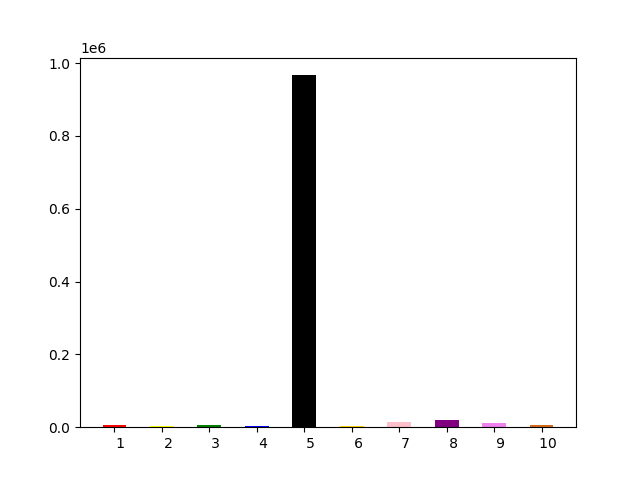

3.根据数据之间的关系,分析两个变量之间的相关系数,画出散点图,并建立变量之间的回归方程(一元或多元)。
1 import pandas as pd 2 3 import numpy as np 4 5 import matplotlib.pyplot as plt 6 7 from pandas import DataFrame,Series 8 9 from sklearn.model_selection import train_test_split 10 11 from sklearn.linear_model import LinearRegression 12 13 import csv 14 15 file_name2 = f'哔哩哔哩番剧top50_20211215_154745.csv' 16 17 filename2 = file_name2 18 19 with open(filename2,encoding="utf_8_sig") as f2: 20 21 reader2 = csv.reader(f2) 22 23 header_row2 = next(reader2) 24 25 print(header_row2) 26 27 for index,column_header in enumerate(header_row2): 28 29 print(index,column_header) 30 31 rank2 = [] 32 33 title2 = [] 34 35 highs2 = [] 36 37 url2 = [] 38 39 visit2 = [] 40 41 new_word2 = [] 42 43 for row in reader2: 44 45 rank2.append(row[0]) 46 47 title2.append(row[1]) 48 49 visit2.append(row[2].strip('\n').strip(' ').strip('\n')) 50 51 highs2.append(row[3].strip('\n').strip(' ').strip('\n')) 52 53 new_word2.append(row[4]) 54 55 url2.append(row[5].strip('\n').strip(' ').strip('\n').strip('//')) 56 57 print(highs2) 58 59 title2 = str(title2) 60 61 title2 = eval(title2) 62 63 visit2 = str(visit2) 64 65 visit2 = visit2.replace('万', '000') 66 67 visit2 = visit2.replace('亿', '0000000') 68 69 visit2 = visit2.replace('.', '') 70 71 visit2 = eval(visit2) 72 73 visit2 = list(map(int, visit2)) 74 75 visit_list_new2 = list(map(int, visit2)) 76 77 highs2 = str(highs2) 78 79 highs2 = highs2.replace('万', '000') 80 81 highs2 = highs2.replace('.', '') 82 83 highs2 = eval(highs2) 84 85 highs_list_new2 = list(map(int, highs2)) 86 87 with open('output.csv','w') as f: 88 89 writer = csv.writer(f) 90 91 writer.writerows(zip(highs_list_new2,visit_list_new2)) 92 93 #创建数据集 94 95 examDict = {'弹幕量':highs_list_new2[0:10], 96 97 '播放量':visit_list_new2[0:10]} 98 99 #转换为DataFrame的数据格式 100 101 examDf = DataFrame(examDict) 102 103 #绘制散点图 104 105 plt.scatter(examDf.播放量,examDf.弹幕量,color = 'b',label = "Exam Data") 106 107 #添加图的标签(x轴,y轴) 108 109 plt.xlabel("Hours") 110 111 plt.ylabel("Score") 112 113 #显示图像 114 115 plt.show() 116 117 rDf = examDf.corr() 118 119 print(rDf) 120 121 exam_X=examDf.弹幕量 122 123 exam_Y=examDf.播放量 124 125 #将原数据集拆分训练集和测试集 126 127 X_train,X_test,Y_train,Y_test = train_test_split(exam_X,exam_Y,train_size=.8) 128 129 #X_train为训练数据标签,X_test为测试数据标签,exam_X为样本特征,exam_y为样本标签,train_size 训练数据占比 130 131 132 133 print("原始数据特征:",exam_X.shape, 134 135 ",训练数据特征:",X_train.shape, 136 137 ",测试数据特征:",X_test.shape) 138 139 140 141 print("原始数据标签:",exam_Y.shape, 142 143 ",训练数据标签:",Y_train.shape, 144 145 ",测试数据标签:",Y_test.shape) 146 147 #散点图 148 149 plt.scatter(X_train, Y_train, color="blue", label="train data") 150 151 plt.scatter(X_test, Y_test, color="red", label="test data") 152 153 154 155 #添加图标标签 156 157 plt.legend(loc=2) 158 159 plt.xlabel("Hours") 160 161 plt.ylabel("Pass") 162 163 #显示图像 164 165 plt.savefig("tests.jpg") 166 167 plt.show() 168 169 model = LinearRegression() 170 171 172 173 #对于模型错误我们需要把我们的训练集进行reshape操作来达到函数所需要的要求 174 175 # model.fit(X_train,Y_train) 176 177 178 179 #reshape如果行数=-1的话可以使我们的数组所改的列数自动按照数组的大小形成新的数组 180 181 #因为model需要二维的数组来进行拟合但是这里只有一个特征所以需要reshape来转换为二维数组 182 183 X_train = X_train.values.reshape(-1,1) 184 185 X_test = X_test.values.reshape(-1,1) 186 187 188 189 model.fit(X_train,Y_train) 190 191 a = model.intercept_#截距 192 193 194 195 b = model.coef_#回归系数 196 197 198 199 print("最佳拟合线:截距",a,",回归系数:",b) 200 201 #训练数据的预测值 202 203 y_train_pred = model.predict(X_train) 204 205 #绘制最佳拟合线:标签用的是训练数据的预测值y_train_pred 206 207 plt.plot(X_train, y_train_pred, color='black', linewidth=3, label="best line") 208 209 210 211 #测试数据散点图 212 213 plt.scatter(X_test, Y_test, color='red', label="test data") 214 215 216 217 #添加图标标签 218 219 plt.legend(loc=2) 220 221 plt.xlabel("Number1") 222 223 plt.ylabel("Number2") 224 225 #显示图像 226 227 plt.savefig("lines.jpg") 228 229 plt.show() 230 231 score = model.score(X_test,Y_test) 232 233 print(score)
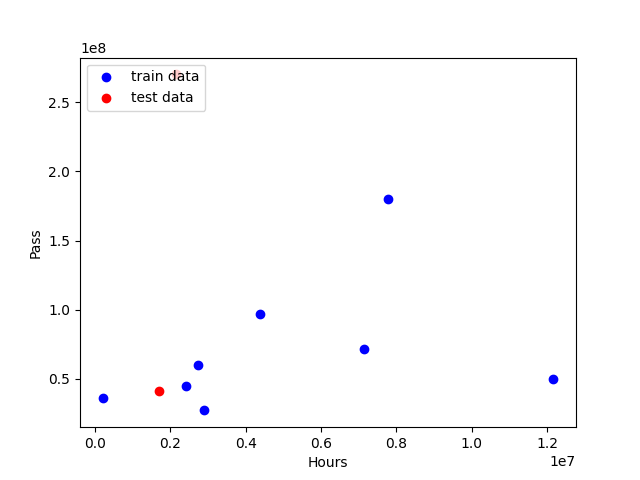
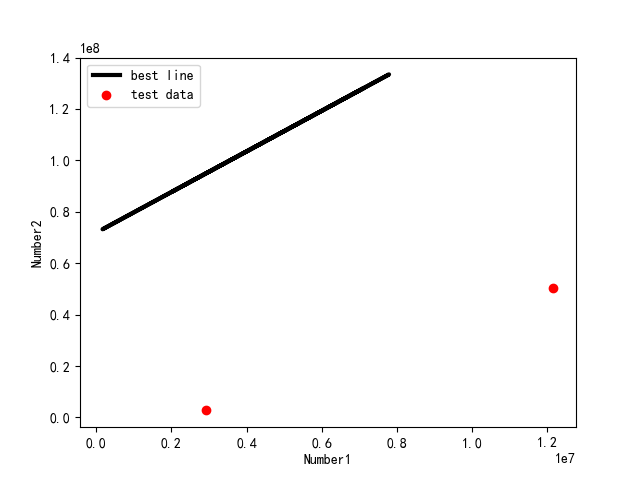
4.数据持久化
1 file_name1 = f'哔哩哔哩视频top100_{now_str}.csv' 2 3 with open(file_name1,'w',newline='',encoding='utf-8') as f: 4 5 writer = csv.writer(f) 6 7 writer.writerow(Video.csv_title()) 8 9 for v in videos: 10 11 writer.writerow(v.to_csv()) 12 13 file_name2 = f'哔哩哔哩番剧top50_{now_str}.csv' 14 15 with open(file_name2,'w',newline='',encoding='utf-8') as f: 16 17 writer = csv.writer(f) 18 19 writer.writerow(Video.csv_title()) 20 21 for v in videos: 22 23 writer.writerow(v.to_csv()) 24 25 plt.savefig(r"C:\Users\24390\Desktop\bilibili-up-v.png")#图片保存 26 27 plt.savefig(r"C:\Users\24390\Desktop\bilibili-draw-v.png")#图片保存
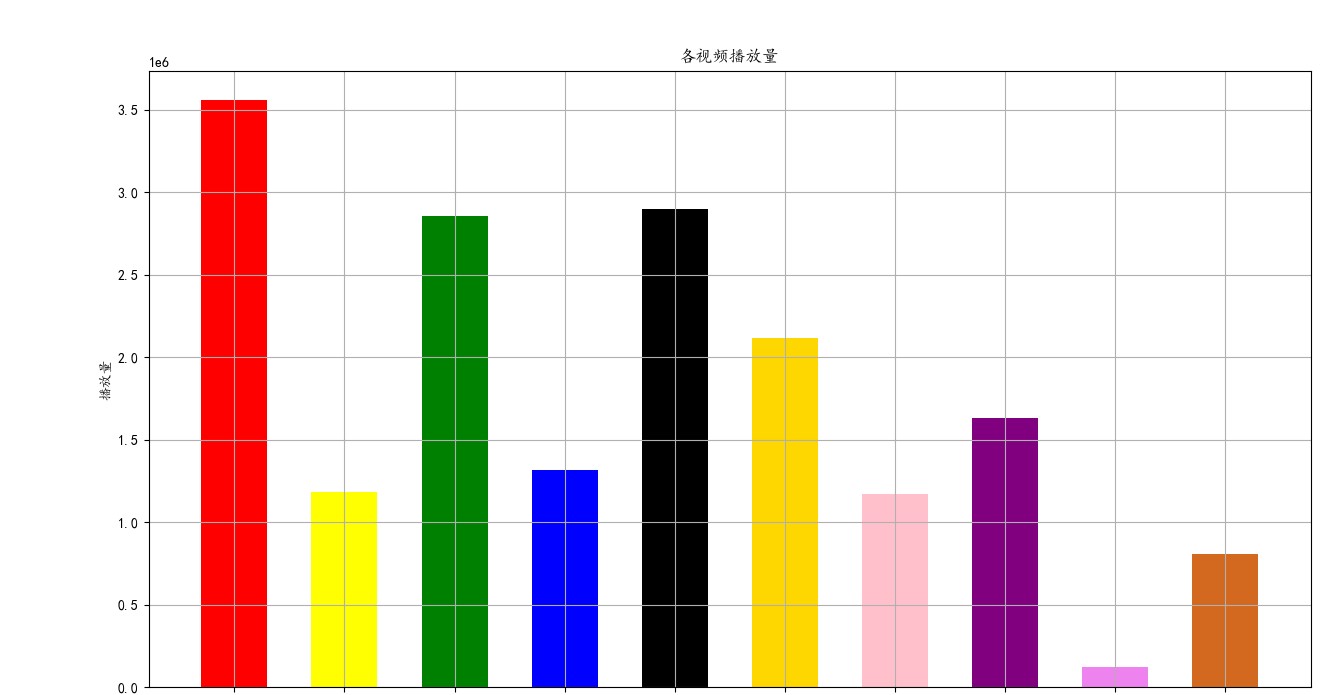
5.将以上各部分的代码汇总,附上完整程序代码
1 import requests 2 3 from bs4 import BeautifulSoup 4 5 import csv 6 7 import datetime 8 9 import pandas as pd 10 11 import numpy as np 12 13 from matplotlib import rcParams 14 15 import matplotlib.pyplot as plt 16 17 import matplotlib.font_manager as font_manager 18 19 from selenium import webdriver 20 21 from time import sleep 22 23 import matplotlib 24 25 from sklearn.model_selection import train_test_split 26 27 from sklearn.linear_model import LinearRegression 28 29 from pandas import DataFrame,Series 30 31 url = 'https://www.bilibili.com/v/popular/rank/all' 32 33 response = requests.get(url)#发起网络请求 34 35 html_text = response.text 36 37 soup = BeautifulSoup(html_text,'html.parser') 38 39 class Video:#创建Video对象 40 41 def __init__(self,rank,title,visit,barrage,up_id,url,space): 42 43 self.rank = rank 44 45 self.title = title 46 47 self.visit = visit 48 49 self.barrage = barrage 50 51 self.up_id = up_id 52 53 self.url = url 54 55 self.space = space 56 57 def to_csv(self): 58 59 return[self.rank,self.title,self.visit,self.barrage,self.up_id,self.url,self.space] 60 61 @staticmethod 62 63 def csv_title(): 64 65 return ['排名','标题','播放量','弹幕量','Up_ID','URL','作者空间'] 66 67 items = soup.findAll('li',{'class':'rank-item'})#提取列表 68 69 videos = []#保存提取出来的Video列表 70 71 for itm in items: 72 73 title = itm.find('a',{'class':'title'}).text #视频标题 74 75 rank = itm.find('i',{'class':'num'}).text #排名 76 77 visit = itm.find_all('span')[3].text #播放量 78 79 barrage = itm.find_all('span')[4].text #弹幕量 80 81 up_id = itm.find('span',{'class':'data-box up-name'}).text #作者id 82 83 url = itm.find_all('a')[1].get('href')#获取视频网址 84 85 space = itm.find_all('a')[2].get('href')#获取作者空间网址 86 87 v = Video(rank,title,visit,barrage,up_id,url,space) 88 89 videos.append(v) 90 91 now_str = datetime.datetime.now().strftime('%Y%m%d_%H%M%S') 92 93 file_name1 = f'哔哩哔哩视频top100_{now_str}.csv' 94 95 with open(file_name1,'w',newline='',encoding='utf-8') as f: 96 97 writer = csv.writer(f) 98 99 writer.writerow(Video.csv_title()) 100 101 for v in videos: 102 103 writer.writerow(v.to_csv()) 104 105 url = 'https://www.bilibili.com/v/popular/rank/bangumi' 106 107 response = requests.get(url)#发起网络请求 108 109 html_text = response.text 110 111 soup = BeautifulSoup(html_text,'html.parser') 112 113 class Video:#创建Video对象 114 115 def __init__(self,rank,title,visit,barrage,new_word,url): 116 117 self.rank = rank 118 119 self.title = title 120 121 self.visit = visit 122 123 self.barrage = barrage 124 125 self.new_word = new_word 126 127 self.url = url 128 129 def to_csv(self): 130 131 return[self.rank,self.title,self.visit,self.barrage,self.new_word,self.url] 132 133 @staticmethod 134 135 def csv_title(): 136 137 return ['排名','标题','播放量','弹幕量','更新话数至','URL'] 138 139 items = soup.findAll('li',{'class':'rank-item'})#提取列表 140 141 videos = []#保存提取出来的Video列表 142 143 for itm in items: 144 145 rank = itm.find('i',{'class':'num'}).text #排名 146 147 title = itm.find('a',{'class':'title'}).text #视频标题 148 149 url = itm.find_all('a')[0].get('href')#获取视频网址 150 151 visit = itm.find_all('span')[2].text #播放量 152 153 barrage = itm.find_all('span')[3].text #弹幕量 154 155 new_word = itm.find('span',{'class':'data-box'}).text#更新话数 156 157 v = Video(rank,title,visit,barrage,new_word,url) 158 159 videos.append(v) 160 161 now_str = datetime.datetime.now().strftime('%Y%m%d_%H%M%S') 162 163 file_name2 = f'哔哩哔哩番剧top50_{now_str}.csv' 164 165 with open(file_name2,'w',newline='',encoding='utf-8') as f: 166 167 writer = csv.writer(f) 168 169 writer.writerow(Video.csv_title()) 170 171 for v in videos: 172 173 writer.writerow(v.to_csv()) 174 175 paiming1 = pd.DataFrame(pd.read_csv(file_name1,encoding="utf_8_sig"))#对数据进行清洗和处理 176 177 paiming2 = pd.DataFrame(pd.read_csv(file_name2,encoding="utf_8_sig")) 178 179 print(paiming1.head()) 180 181 print(paiming2.head()) 182 183 print(paiming1.duplicated())#查找重复值 184 185 print(paiming2.duplicated()) 186 187 print(paiming1['标题'].isnull().value_counts())#查找空值与缺失值 188 189 print(paiming2['标题'].isnull().value_counts()) 190 191 print(paiming1['URL'].isnull().value_counts()) 192 193 print(paiming2['URL'].isnull().value_counts()) 194 195 print(paiming1['播放量'].isnull().value_counts()) 196 197 print(paiming2['播放量'].isnull().value_counts()) 198 199 print(paiming1['弹幕量'].isnull().value_counts()) 200 201 print(paiming2['弹幕量'].isnull().value_counts()) 202 203 #数据分析以及可视化 204 205 filename1 = file_name1 206 207 filename2 = file_name2 208 209 with open(filename1,encoding="utf_8_sig") as f1: 210 211 reader1 = csv.reader(f1)#创建阅读器(调用csv.reader()将前面存储的文件对象最为实参传给它) 212 213 header_row1 = next(reader1)#调用了next()一次,所以这边只调用了文件的第一行,并将头文件存储在header_row中 214 215 print(header_row1) 216 217 for index,column_header in enumerate(header_row1):#指出每个头文件的索引 218 219 print(index,column_header) 220 221 title1 = [] 222 223 rank1 = [] 224 225 highs1=[] 226 227 url1 = [] 228 229 visit1 = [] 230 231 space1 = [] 232 233 up_id1 = [] 234 235 for row in reader1: 236 237 rank1.append(row[0]) 238 239 title1.append(row[1]) 240 241 visit1.append(row[2].strip('\n').strip(' ').strip('\n')) 242 243 highs1.append(row[3].strip('\n').strip(' ').strip('\n')) 244 245 up_id1.append(row[4].strip('\n').strip(' ').strip('\n')) 246 247 url1.append(row[5].strip('\n').strip(' ').strip('\n').strip('//')) 248 249 space1.append(row[6].strip('\n').strip(' ').strip('\n').strip('//')) 250 251 visit1 = str(visit1) 252 253 visit1 = visit1.replace('万', '000') 254 255 visit1 = visit1.replace('.', '') 256 257 visit1 = eval(visit1) 258 259 visit_list_new1 = list(map(int, visit1)) 260 261 highs1 = str(highs1) 262 263 highs1 = highs1.replace('万', '000') 264 265 highs1 = highs1.replace('.', '') 266 267 highs1 = eval(highs1) 268 269 highs_list_new1 = list(map(int, highs1)) 270 271 print(highs_list_new1) 272 273 x=np.array(rank1[0:10])#设置x轴数据 274 275 y=np.array(highs_list_new1[0:10])#设置y轴数据 276 277 plt.bar(x,y,color = ["red","yellow","green","blue","black","gold","pink","purple","violet","Chocolate"],width = 0.5)# 绘制柱状图,并把每根柱子的颜色设置自己的喜欢的颜色,顺便设置每根柱子的宽度 278 279 plt.show() 280 281 x=np.array(title1[0:10])#设置x轴数据 282 283 y=np.array(visit_list_new1[0:10])#设置y轴数据 284 285 plt.bar(x,y,color = ["red","yellow","green","blue","black","gold","pink","purple","violet","Chocolate"],width = 0.5)# 绘制柱状图,并把每根柱子的颜色设置自己的喜欢的颜色,顺便设置每根柱子的宽度 286 287 matplotlib.rcParams['font.sans-serif'] = ['KaiTi'] 288 289 plt.show() 290 291 fig = plt.figure(figsize = (15,8))#定义画布的大小 292 293 plt.title("各视频播放量")#添加主标题 294 295 plt.xlabel("视频名称")#设置X周与Y周的标题 296 297 plt.ylabel("播放量") 298 299 plt.grid(True)# 显示网格线 300 301 x=np.array(title1[0:10])#设置x轴数据 302 303 y=np.array(visit_list_new1[0:10])#设置y轴数据 304 305 plt.bar(x,y,color = ["red","yellow","green","blue","black","gold","pink","purple","violet","Chocolate"],width = 0.6)#绘制柱状图,并把每根柱子的颜色设置自己的喜欢的颜色,顺便设置每根柱子的宽度 306 307 plt.savefig(r"C:\Users\24390\Desktop\bilibili-up-v.png")#图片保存 308 309 with open(filename2,encoding="utf_8_sig") as f2: 310 311 reader2 = csv.reader(f2) 312 313 header_row2 = next(reader2) 314 315 print(header_row2) 316 317 for index,column_header in enumerate(header_row2): 318 319 print(index,column_header) 320 321 rank2 = [] 322 323 title2 = [] 324 325 highs2 = [] 326 327 url2 = [] 328 329 visit2 = [] 330 331 new_word2 = [] 332 333 for row in reader2: 334 335 rank2.append(row[0]) 336 337 title2.append(row[1]) 338 339 visit2.append(row[2].strip('\n').strip(' ').strip('\n')) 340 341 highs2.append(row[3].strip('\n').strip(' ').strip('\n')) 342 343 new_word2.append(row[4]) 344 345 url2.append(row[5].strip('\n').strip(' ').strip('\n').strip('//')) 346 347 print(highs2) 348 349 title2 = str(title2) 350 351 title2 = eval(title2) 352 353 visit2 = str(visit2) 354 355 visit2 = visit2.replace('万', '000') 356 357 visit2 = visit2.replace('亿', '0000000') 358 359 visit2 = visit2.replace('.', '') 360 361 visit2 = eval(visit2) 362 363 visit2 = list(map(int, visit2)) 364 365 visit_list_new2 = list(map(int, visit2)) 366 367 highs2 = str(highs2) 368 369 highs2 = highs2.replace('万', '000') 370 371 highs2 = highs2.replace('.', '') 372 373 highs2 = eval(highs2) 374 375 highs_list_new2 = list(map(int, highs2)) 376 377 print(highs_list_new2) 378 379 x=np.array(rank2[0:10])#设置x轴数据 380 381 y=np.array(highs_list_new2[0:10])#设置y轴数据 382 383 plt.bar(x,y,color = ["red","yellow","green","blue","black","gold","pink","purple","violet","Chocolate"],width = 0.5)# 绘制柱状图,并把每根柱子的颜色设置自己的喜欢的颜色,顺便设置每根柱子的宽度 384 385 plt.show() 386 387 x=np.array(title2[0:10])#设置x轴数据 388 389 y=np.array(visit_list_new2[0:10])#设置y轴数据 390 391 plt.bar(x,y,color = ["red","yellow","green","blue","black","gold","pink","purple","violet","Chocolate"],width = 0.5)# 绘制柱状图,并把每根柱子的颜色设置自己的喜欢的颜色,顺便设置每根柱子的宽度 392 393 matplotlib.rcParams['font.sans-serif'] = ['KaiTi'] 394 395 plt.show() 396 397 fig = plt.figure(figsize = (15,8))# 定义画布的大小 398 399 plt.title("番剧播放量")#添加主标题 400 401 plt.xlabel("番剧名称")#设置X周与Y周的标题 402 403 plt.ylabel("播放量") 404 405 plt.grid(True)# 显示网格线 406 407 x=np.array(title2[0:10])#设置x轴数据 408 409 y=np.array(visit_list_new2[0:10])#设置y轴数据 410 411 plt.bar(x,y,color = ["red","yellow","green","blue","black","gold","pink","purple","violet","Chocolate"],width = 0.6)# 绘制柱状图,并把每根柱子的颜色设置自己的喜欢的颜色,顺便设置每根柱子的宽度 412 413 plt.savefig(r"C:\Users\24390\Desktop\bilibili-draw-v.png")#图片保存 414 415 with open('output.csv','w') as f: 416 417 writer = csv.writer(f) 418 419 writer.writerows(zip(highs_list_new2,visit_list_new2)) 420 421 #创建数据集 422 423 examDict = {'弹幕量':highs_list_new2[0:10], 424 425 '播放量':visit_list_new2[0:10]} 426 427 #转换为DataFrame的数据格式 428 429 examDf = DataFrame(examDict) 430 431 #绘制散点图 432 433 plt.scatter(examDf.播放量,examDf.弹幕量,color = 'b',label = "Exam Data") 434 435 #添加图的标签(x轴,y轴) 436 437 plt.xlabel("Hours") 438 439 plt.ylabel("Score") 440 441 #显示图像 442 443 plt.show() 444 445 rDf = examDf.corr() 446 447 print(rDf) 448 449 exam_X=examDf.弹幕量 450 451 exam_Y=examDf.播放量 452 453 #将原数据集拆分训练集和测试集 454 455 X_train,X_test,Y_train,Y_test = train_test_split(exam_X,exam_Y,train_size=.8) 456 457 #X_train为训练数据标签,X_test为测试数据标签,exam_X为样本特征,exam_y为样本标签,train_size 训练数据占比 458 459 460 461 print("原始数据特征:",exam_X.shape, 462 463 ",训练数据特征:",X_train.shape, 464 465 ",测试数据特征:",X_test.shape) 466 467 468 469 print("原始数据标签:",exam_Y.shape, 470 471 ",训练数据标签:",Y_train.shape, 472 473 ",测试数据标签:",Y_test.shape) 474 475 #散点图 476 477 plt.scatter(X_train, Y_train, color="blue", label="train data") 478 479 plt.scatter(X_test, Y_test, color="red", label="test data") 480 481 482 483 #添加图标标签 484 485 plt.legend(loc=2) 486 487 plt.xlabel("Hours") 488 489 plt.ylabel("Pass") 490 491 #显示图像 492 493 plt.savefig("tests.jpg") 494 495 plt.show() 496 497 model = LinearRegression() 498 499 500 501 #对于模型错误我们需要把我们的训练集进行reshape操作来达到函数所需要的要求 502 503 # model.fit(X_train,Y_train) 504 505 506 507 #reshape如果行数=-1的话可以使我们的数组所改的列数自动按照数组的大小形成新的数组 508 509 #因为model需要二维的数组来进行拟合但是这里只有一个特征所以需要reshape来转换为二维数组 510 511 X_train = X_train.values.reshape(-1,1) 512 513 X_test = X_test.values.reshape(-1,1) 514 515 516 517 model.fit(X_train,Y_train) 518 519 a = model.intercept_#截距 520 521 522 523 b = model.coef_#回归系数 524 525 526 527 print("最佳拟合线:截距",a,",回归系数:",b) 528 529 #训练数据的预测值 530 531 y_train_pred = model.predict(X_train) 532 533 #绘制最佳拟合线:标签用的是训练数据的预测值y_train_pred 534 535 plt.plot(X_train, y_train_pred, color='black', linewidth=3, label="best line") 536 537 538 539 #测试数据散点图 540 541 plt.scatter(X_test, Y_test, color='red', label="test data") 542 543 544 545 #添加图标标签 546 547 plt.legend(loc=2) 548 549 plt.xlabel("Number1") 550 551 plt.ylabel("Number2") 552 553 #显示图像 554 555 plt.savefig("lines.jpg") 556 557 plt.show() 558 559 score = model.score(X_test,Y_test) 560 561 print(score) 562 563 print(title1[1],title2[1]) 564 565 print('请问您想观看UP主视频还是番剧亦或者是查询UP主的空间页面?\n观看UP主视频请扣1,观看番剧请扣2,查询UP主空间页面请扣3。') 566 567 z = int(input()) 568 569 if z == int(2): 570 571 print(title2) 572 573 print('请输入您想观看的番剧:') 574 575 name = input() 576 577 i=0 578 579 for i in range(0,50,1): 580 581 if title2[i]==name: 582 583 print(i) 584 585 break 586 587 print(url2[i]) 588 589 to_url2=url2[i] 590 591 d = webdriver.Chrome()#打开谷歌浏览器,并且赋值给变量d 592 593 d.get('https://'+to_url2)#通过get()方法,在当前窗口打开网页 594 595 sleep(2) 596 597 elif z == int(1): 598 599 print(title1) 600 601 print('请输入您想观看的UP主视频:') 602 603 name = input() 604 605 i=0 606 607 for i in range(0,100,1): 608 609 if title1[i]==name: 610 611 print(i) 612 613 break 614 615 print(url1[i]) 616 617 to_url1=url1[i] 618 619 d = webdriver.Chrome()#打开谷歌浏览器,并且赋值给变量d 620 621 d.get('https://'+to_url1)#通过get()方法,在当前窗口打开网页 622 623 sleep(2) 624 625 elif z == int(3): 626 627 print(up_id1) 628 629 print('请输入您想查询的UP主空间:') 630 631 name = input() 632 633 i=0 634 635 for i in range(0,100,1): 636 637 if up_id1[i]==name: 638 639 print(i) 640 641 break 642 643 print(space1[i]) 644 645 to_space11=space1[i] 646 647 d = webdriver.Chrome()#打开谷歌浏览器,并且赋值给变量d 648 649 d.get('https://'+to_space11)#通过get()方法,在当前窗口打开网页 650 651 sleep(2) 652 653 else: 654 655 print('输入不符合要求')
三、 总结
1.经过对主题数据的分析与可视化,可以得到哪些结论?是否达到预期的目标?
结论:本次课程设计,影响最深的就是在遇到问题时候,可以通过网上了解BUG问题的原因并很好地解决,在设计课程时候,可以考虑与机器学习以及其他方面进行结合本次课程所绘制的散点图与直方图等不只局限于课程爬虫设计这一主题,其中还涉及到对机器主题的应用,让我明白了设计课题主题的知识广泛与应用。
目标:首先需要学好网络爬虫基本的步骤request请求与存储。采集信息并提取出来进行可视化绘制也是我下次要学习的重点。实行数据的持久化可以减少对所获取的数据的清洗与处理次数。这次的课程设计使我明白了要加强对python的了解与理解,才能迅速的找到自己不足的地方并且专攻下来,争取推动自己对python的进程。


 浙公网安备 33010602011771号
浙公网安备 33010602011771号